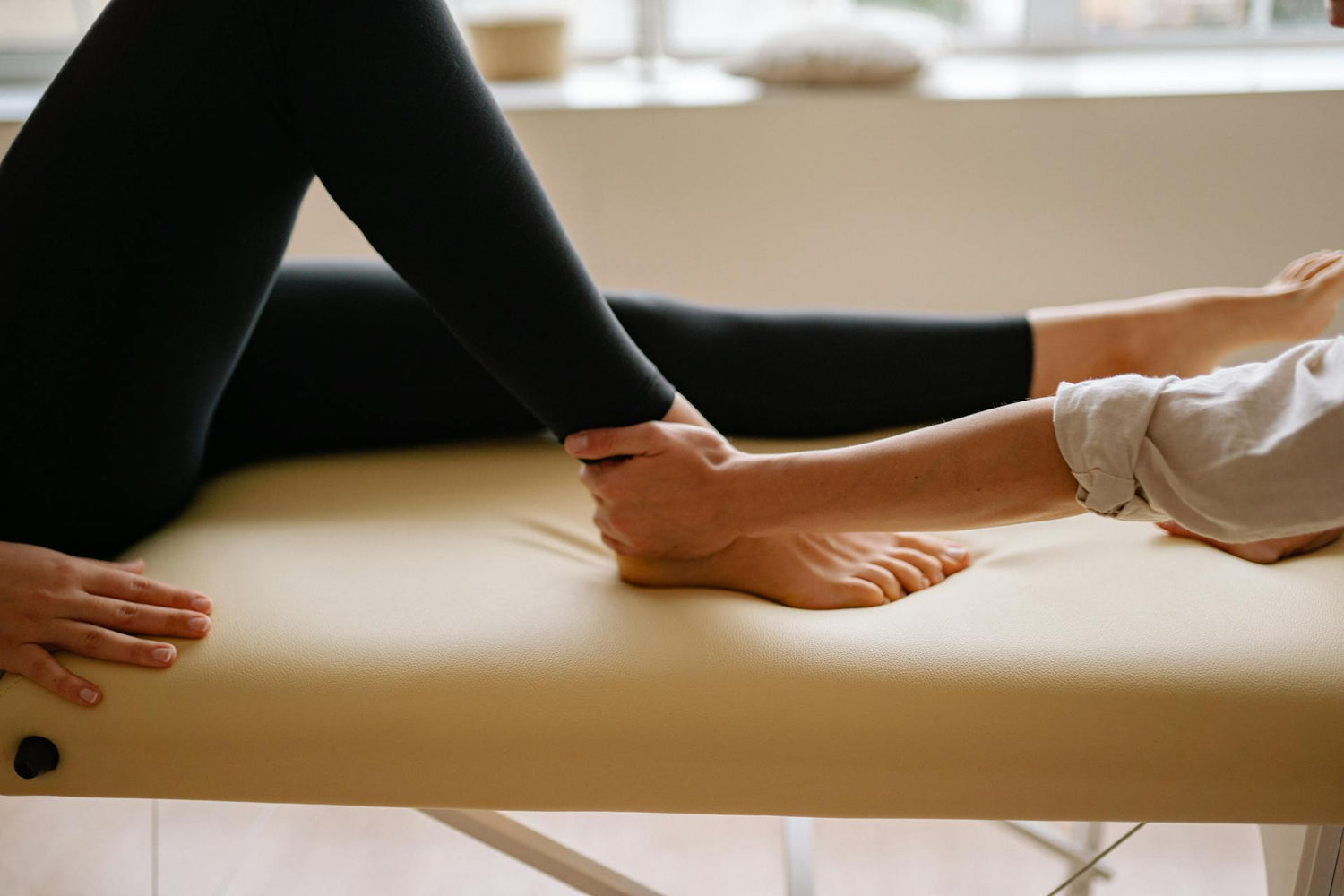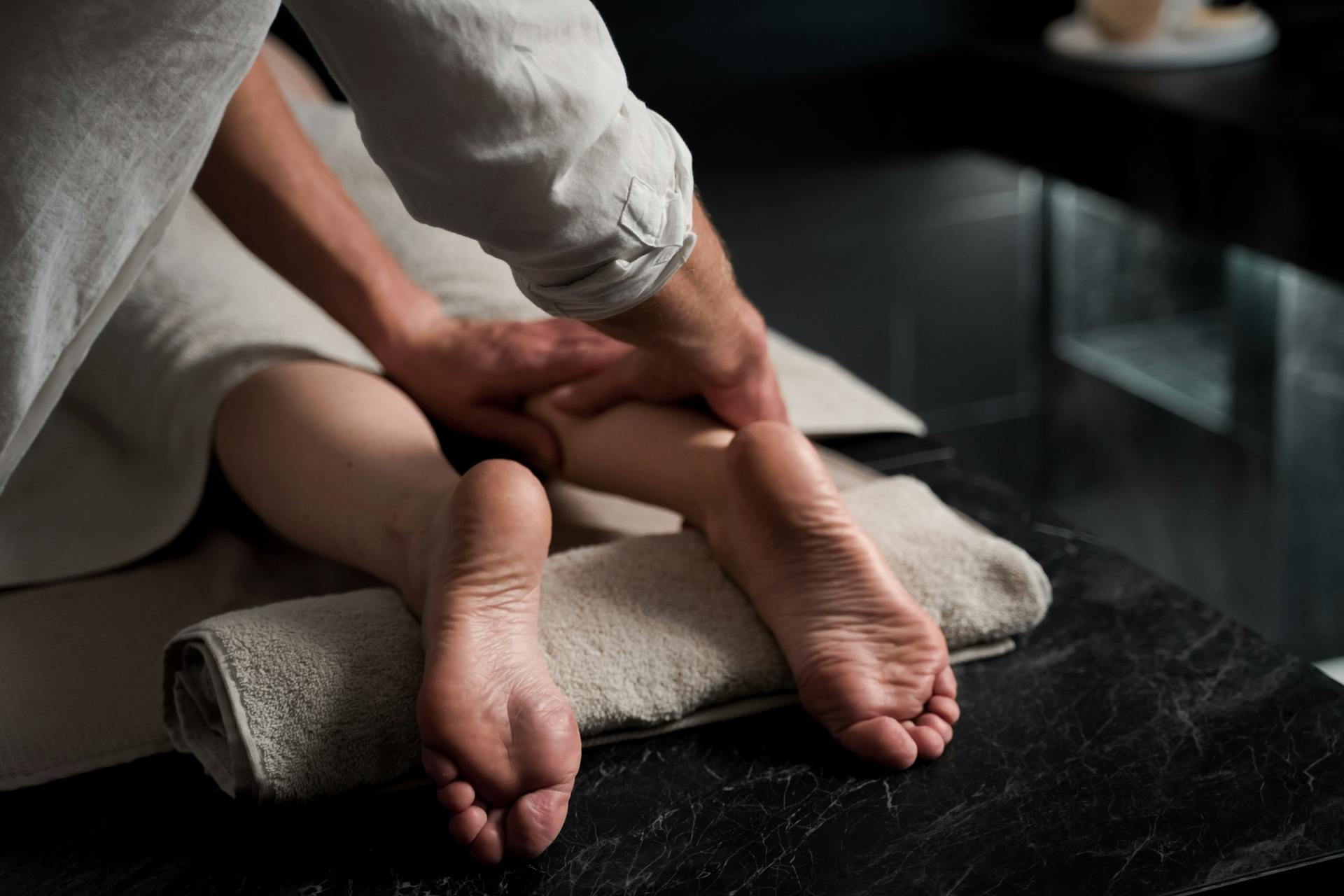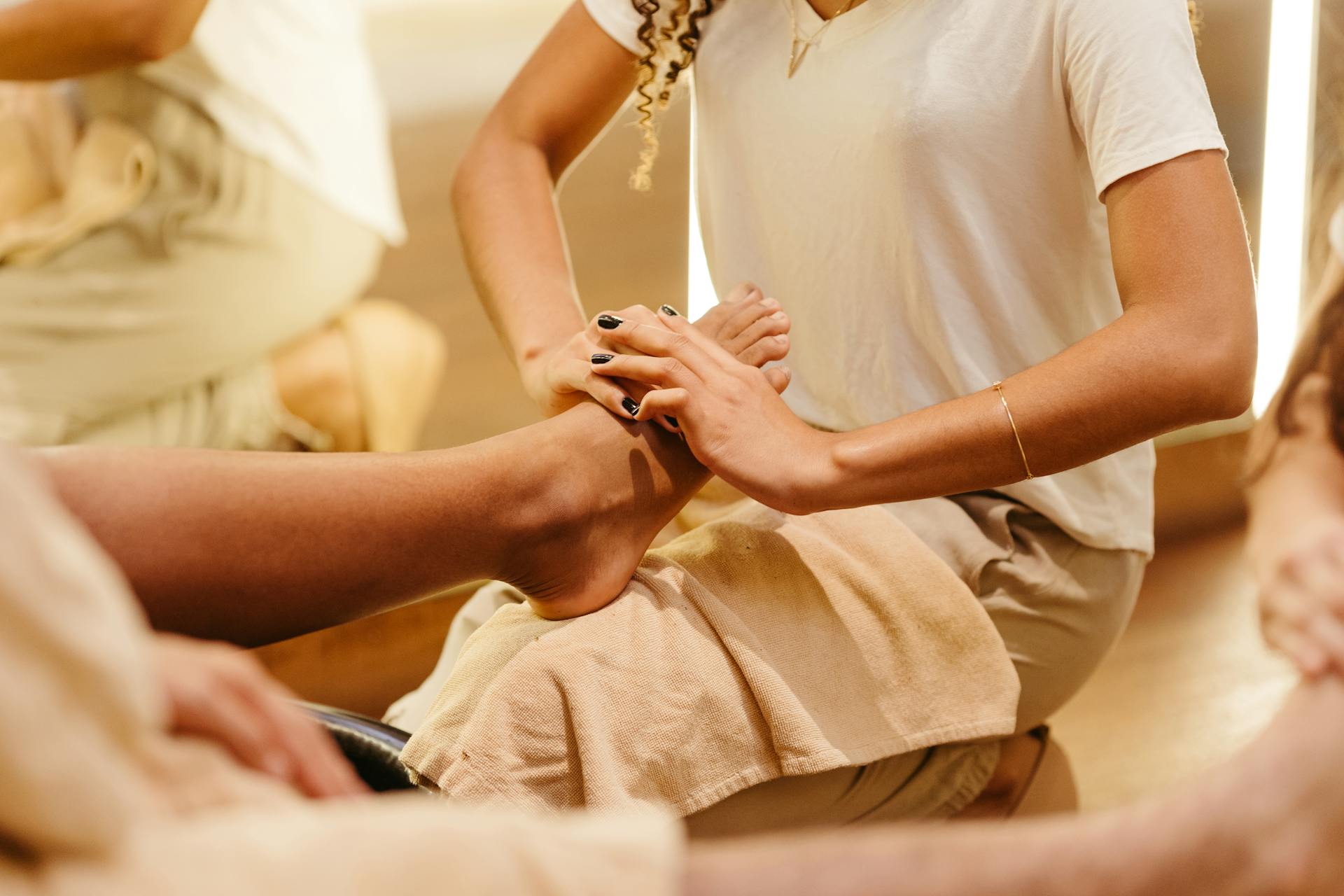Our feet are made of many intricate pieces — 26 bones, 33 joints, and countless muscles, ligaments, and tendons that help us run, walk, jump, and move around the world.
When something goes wrong with these complex parts — like in the case of foot tendonitis — it can take a major toll on your daily routine. But alongside the right treatment plan, could foot massage help with pain relief?
Read on for a complete guide to massage for foot tendonitis, including the benefits, techniques, and safety tips to keep in mind.
What Causes Foot Tendonitis?
Tendons are thick, fibrous bands of tissue that link your muscles to your bones. Tendonitis happens when these tissues become inflamed — typically because of repeated strain from high-impact activities.
Mild tendon inflammation usually heals up on its own without any overly intrusive pain. But if you overstrain your tendons — or simply don’t give them enough time to rest — you may end up with a case of foot tendonitis.
Foot tendonitis can also happen more often as you get older, since your tendons, ligaments, and other supportive tissues tend to become a bit weaker (and less resilient to intense activity) over time.
Other risk factors may include:
- Lack of stretching before or after workouts
- Being overweight
- Specific conditions like gout, flat feet, diabetes, etc.
- Tightness or history of tendon issues
- Smoking
Common Types of Foot Tendonitis
Foot tendonitis often springs up in the ankles, but it can impact the top, side, or soles of your feet, too. The most common types of foot tendonitis include:
Achilles Tendonitis
As the connector between your calf and heel bone, the Achilles tendon is the largest tendon in your body. Not only does it absorb shock with every step you take, but it also helps you rotate, engage, and flex your foot and ankle.
Because it’s such a busy tendon, it’s also one of the most prone to overuse. In fact, studies estimate that up to one million athletes deal with Achilles issues each year.
That being said, you might be more likely to get Achilles tendonitis if you’re a runner, sprinter, basketball player, or other kind of athlete. But it can also affect those who are middle-to-older age and only play sports sometimes, or even those who don’t exercise at all.
Extensor Tendonitis
Extensor tendonitis can affect the back of your hands or the tops of your feet, between your toes and your ankle. It happens when the tendons that help you straighten your foot (or hand) become inflamed.
When you have extensor tendonitis, you might notice top-of-foot pain while walking, running, or working out.
The good news is that this condition is usually temporary and heals on its own — as long as you give your foot the TLC it needs to recover.
Other Types of Foot Tendonitis
Extensor tendonitis and Achilles tendonitis can be common in the feet and ankles. But other types of foot tendonitis include:
- Peroneal tendonitis: Your peroneal tendons run on the outer side of your ankle, connecting to the middle of your foot to help with stability. Tendonitis here can feel like general ankle pain and swelling. But it can also cause pain along the outer edge of your foot.
- Posterior tibial tendonitis: Your posterior tibial tendon connects your calf to the inside of your foot. When this tendon becomes inflamed, it can cause pain on the inside of your foot, making it difficult to point your feet inward.
What About Plantar Fasciitis?
If you’re a runner, chances are you’ve heard of plantar fasciitis. While this common heel condition can feel like foot tendonitis, the plantar fascia is technically a ligament — so it doesn’t quite fall in the same category.
With that in mind, the recovery plans for mild plantar fasciitis can look similar to those for tendonitis. For example, your doctor might recommend:
- Rest, ice, elevation, and compression
- Physical therapy
- Orthotics or shoe inserts
3 Potential Benefits of Massage for Foot Tendonitis

We all know that massage therapy feels great — and its benefits can impact your body on a holistic level. But when it comes to massage for foot tendonitis, the right techniques may help with:
Pain Relief
If you’ve ever had a back rub after a long day, you know how powerful a massage can be for pain. This is true when you have sore feet, too.
A good massage helps stimulate and relax the muscles, which can lead to a noticeable dip in your discomfort. But beyond that, some experts theorize that massage helps “close the pain gate” — which could be another reason it feels so relaxing.
What exactly does this mean? In short, the pressure may help stimulate competing neural pathways in your muscles when you have pain. This could explain why massaging a sore spot can often bring quick relief, even if it’s for a short while.
Soothing Stiffness and Tension
Gently massaging the muscles around your pain point can relieve muscle tension in your feet and ankles. And as a result, it could help take some of the pressure off your sore tendons.
Massage soothes stiff muscles in a few ways, including:
- Manually stretching and lengthening the tissue
- Relaxing the body (which relaxes the muscles)
- Breaking up trigger points or adhesions
Stimulating Healthy Blood Flow
Beyond relaxation and pain relief, the pressure and warmth of massage can also help encourage blood flow.
Kneading, rubbing, and vibrating motions help manually promote healthy circulation. At the same time, the warmth from the friction can help your blood vessels dilate.
The result? A proper foot massage could support your body in delivering nutrients and oxygen to areas that need it most.
When Is It Safe to Use Massage for Foot Tendonitis?
Because foot tendonitis is an injury, it’s important not to start massaging it right away. Most of the time, you’ll need to ensure you’re outside of the “acute” window before applying pressure near sore tendons.
This may be after a few days, a week, or more. Ultimately, it’ll depend on your specific injury, and how far along you are in the healing process.
With that being said, it’s always key to get the OK from your doctor before massaging any injury, including foot tendonitis.
Massage for Foot Tendonitis: 5 Easy Techniques

Once you’ve got the green light to try massage for foot tendonitis, here’s some good news: foot massage is incredibly easy and accessible to try at home.
Below you’ll find five simple techniques to help you find relief:
1. Full Foot and Calf Rub
A foot and calf rub is a great way to give yourself restorative relief with broad, gentle pressure. To try it:
- Sit in a comfortable chair, and cross one leg up over your knee.
- Apply a small amount of oil or lotion to the calf and foot.
- Use light gliding motions to begin warming up the calf muscle, slowly making your way to the bottom of the foot. Repeat for 1–2 minutes.
- Next, wrap both hands around your calf muscle. Massage using light kneading (or squeezing) motions, and make your way toward the ankle.
- Then, repeat these motions down the length of the foot.
- Finish by spending a few seconds gently bending the toes forward and backward.
2. Ankle Relaxation Massage
If you’ve been dealing with Achilles tendonitis, a light ankle massage to the muscles surrounding the tendon could help you find some relief.
Not only can this technique increase the blood flow, but it can also help decrease the tension around your pain point.
Here’s how to try it:
- Sit somewhere comfortable, and lean down to reach your foot and ankle.
- Use light, broad glides with both hands to gently warm up the muscles around your ankle, both in the calf and near the foot.
- Then, deepen the pressure slightly. Use kneading (or squeezing) motions to deliver deeper massage to your lower leg muscles.
- After 2–3 minutes, cross the foot up over your leg.
- Finish the massage by gently rolling your foot in circles for 20–30 seconds to stretch your muscles and boost blood flow.
3. Arch Twists
Arch twists are a simple, fast massage technique that can work excellently on their own or as part of a deeper foot massage.
To try them:
- Cross your foot up over your knee.
- Wrap both hands around your foot, with your thumbs parallel in the center of your arch.
- Lightly tighten your right hand’s grip, and massage the thumb outward.
- As you’re moving your right thumb outward, repeat the motion with the left hand.
- Make your way up the entire length of the foot.
- Optionally, finish the massage by using your thumb to massage the heel in circular motions.
- Massage for a total of 5–10 minutes.
4. Rolling Foot Massage
Massage balls can provide a semi-passive way to massage your feet while you relax, watch your favorite show, or work at your desk.
Rolling foot massages focus on the bottom of the feet — meaning they can be a helpful tool for soothing sole or heel pain.
Simply:
- Grab a golf ball, lacrosse ball, tennis ball, or a mini therapeutic ball like this one.
- Place the ball in front of you.
- Begin to roll your foot over it with light-to-moderate pressure. Pay attention to what feels good and relaxing, and be mindful not to aggravate any pain.
- Spend a few seconds focusing on your arch, the outer edge of your foot, the ball of your foot, and your heel.
- Roll for a total of 3–5 minutes.
5. Oscillating Massage
An oscillating foot massager can help you get hands-off, restorative foot massage at home. And if you’re healing from foot tendonitis, you can check with your doctor about when to use one of these machines — and which one might be a good fit for you.
The MedMassager Foot Massager Classic is one option with customizable speed and pressure settings, plus oscillating technology to deliver deep relief to the feet and calves.
To try a massager like this:
- Place your feet on the massage surface, and set it to the lowest speed.
- After 30–60 seconds, turn it up to the pressure level that feels best to you.
- Allow the massage motions to work deeply into your feet for 5–10 minutes.
- Optionally, flip the massager around and place your calves on the surface for an added lower leg massage.
Massage for Foot Tendonitis: Tips for Maximum Relief
To keep your feet safe (and maximize your relief), here are a few tips to keep in mind as you try massage for foot tendonitis:
- Be sure not to overdo it. Professional deep tissue massage can sometimes feel like it hurts in a good way. But in the case of massage for foot tendonitis, it’s better to keep the pressure light and increase gradually. This way, you can avoid worsening any inflammation.
- Chat with your doctor first. They can help you decide when (and how) to best add massage to your remedy toolkit.
- Tools like aromatherapy, heat, and cold can help you reap even deeper relief from your massage.
- Don’t prioritize massage over other treatments that your doctor recommends. While it can be a wonderfully soothing tool, it’s not a cure-all, and it works best in the context of a more comprehensive treatment plan.
Other Tips for Foot Tendonitis Relief
Aside from using massage for foot tendonitis, here are some other tried and true remedies that could bring a boost of comfort to sore feet:
RICE Method
Your doctor might recommend the RICE method in the first few days after you notice your pain. This stands for:
- Rest
- Ice
- Compression
- Elevation
When injuries happen, the RICE method gives your body a chance to heal while managing inflammation. After a few days, your doctor may give you the OK to start soothing your symptoms with other home remedies.
Use Heat or Cold to Soothe Pain
Both heat and cold can be helpful tools for pain, but it all comes down to what feels best to you.
According to the Mayo Clinic, heat can be a good way to boost blood flow and encourage tendon healing. On the flip side, cold therapy can help you soothe inflammation and swelling in the earlier stages of your pain.
You can use heat by:
- Soaking your feet in a warm bath
- Using a warm compress
If you prefer cold, you can try:
- Short bouts of ice massage (2–4) minutes a few times per day
- Using a cold pack for 10–15 minutes every few hours
Stretches and Exercises
By teaming up with a physical therapist, you can find exercises to target, strengthen, and mobilize your feet and ankles.
With foot tendonitis, the goal of physical therapy is to make sure your tendon heals properly, all while strengthening the muscles supporting it.
Your therapist will help you choose the right stretches and exercises to help with your healing journey. These can vary from person to person, but they may include:
- Standing or sitting calf stretches
- Ankle mobility stretches
- Calf and ankle strengthening exercises
- Balance and stability exercises
Preventing Future Foot Tendonitis
Here are a few steps you can take to prevent foot tendonitis pain from coming back once it heals, according to the Cleveland Clinic:
- Listen to your body while you’re exercising or playing sports. If your foot pain is telling you to take a break, it’s probably best to dial things back for a while.
- Start light and slowly increase intensity during activities. This gives your tendons and muscles a chance to warm up and get blood flowing.
- Add some warm-up and cooldown stretches to your routines.
- Try your best to maintain a healthy weight.
- Wear the right shoes for your foot shape, and consider visiting a podiatrist to see if orthotic inserts could be right for you.
The Bottom Line
Massage for foot tendonitis can be a soothing way to ease pain, melt away stiffness, and encourage healthy blood flow. And whether you use hands-on techniques or opt for a therapeutic tool, it’s a convenient remedy to try at home.
With that in mind, remember to avoid putting pressure on your feet too soon after any tendon injury — and if you’re not sure about your timeline, it’s always best to check with your doctor first. In addition, ask about foot massage if you have any medical conditions that haven’t been OK’d for it in the past.
With the right remedies and tools, you can get back on track to business as usual — without foot or ankle pain impacting your daily stride.
Get Soothing Foot Massage at Home
Pick up the MedMassager Foot Massager Classic today, or learn more about its many restorative benefits here.



